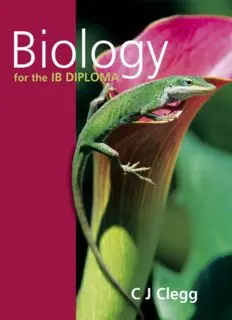
Biology for the IB Diploma + CD PDF
Preview Biology for the IB Diploma + CD
Biology for the IB DIPLOMA This page intentionally left blank Biology for the IB DIPLOMA C J Clegg PART OF HACHETTE LIVRE UK Thecoverimageshowsagreenanole(Anoliscarolinensis),atree-dwellingreptilefoundinpartsofNorthandSouth Americathatmaygrowtoalengthof20cm.Hereitisperchedmomentarilyuponapitcherplant.Theseactive,agile carnivoreshavepadsontheirfeetthatenablethemtocling,climbandrunonvirtuallyanysurface,astheyhuntfor crickets,cockroaches,spidersandmoths.Preyiscaughtinthewidejaws,withtheaidofalong,forkedtongue.Their skinischaracteristicallyscaly,andtheanole,typicallygreencoloured,canchangeitscolour,astherelatedchameleon lizardsdo. Pitcherplantsareexamplesof‘carnivorous’plants;theygrowandcompetewellonsoilstypicallydeficientin essentialions,suchasnitrates.Thesephotosyntheticorganismstrapinsectsandothertinyanimalsintheirtall-sided pitchers,linedinternallywithsmooth,down-pointingscales.Whenthe‘prey’diesitdecaysbybacterialaction,aided byenzymessecretedinthepitcher.Theionsreleasedareactivelyabsorbedintotheplant’scells,enablingessential metabolicprocessessuchasproteinsynthesis. This ebook does not include the ancillary material that was included with the printed version of the book Althougheveryefforthasbeenmadetoensurethatwebsiteaddressesarecorrectattimeofgoingtopress,Hodder Educationcannotbeheldresponsibleforthecontentofanywebsitementionedinthisbook.Itissometimespossibleto findarelocatedwebpagebytypingintheaddressofthehomepageforawebsiteintheURLwindowofyourbrowser. Hachette’spolicyistousepapersthatarenatural,renewableandrecyclableproductsandmadefromwoodgrownin sustainableforests.Theloggingandmanufacturingprocessesareexpectedtoconformtotheenvironmentalregulationsof thecountryoforigin. Thismaterialhasbeendevelopedindependentlybythepublisherandthecontentisinnowayconnectedwith,nor endorsedby,theInternationalBaccalaureateOrganization. Orders:pleasecontactBookpointLtd,130MiltonPark,Abingdon,OxonOX144SB.Telephone:(44)01235827720. Fax:(44)01235400454.Linesareopen9.00–5.00,MondaytoSaturday,witha24-hourmessageansweringservice.Visit ourwebsiteatwww.hoddereducation.co.uk. ©C.J.Clegg2007 Firstpublishedin2007by HodderMurray,animprintofHodderEducation, partofHachetteLivreUK, 338EustonRoad LondonNW13BH Impressionnumber 5 4 3 2 Year 2010 2009 2008 Allrightsreserved.ApartfromanyusepermittedunderUKcopyrightlaw,nopartofthispublicationmaybereproduced ortransmittedinanyformorbyanymeans,electronicormechanical,includingphotocopyingandrecording,orheld withinanyinformationstorageandretrievalsystem,withoutpermissioninwritingfromthepublisherorunderlicence fromtheCopyrightLicensingAgencyLimited.Furtherdetailsofsuchlicences(forreprographicreproduction)maybe obtainedfromtheCopyrightLicensingAgencyLimited,SaffronHouse,6–10KirbyStreet,LondonEC1N8TS. Coverphoto©DavidAubrey/SciencePhotoLibrary IllustrationsbyOxfordDesigners&Illustrators,BarkingDogArt Typesetin10/12ptGoudyandFrutigerfamiliesbyEricDrewery PrintedinItaly AcataloguerecordforthistitleisavailablefromtheBritishLibrary ISBN:9780340926529 Some figures in the printed version of this book are not available for inclusion in the eBook for copyright reasons. Contents Introduction ix MatchingchapterswiththeIBDiplomabiologysyllabus xi Section 1: Standard level and higher level Chapter 1 Cells – the building blocks 1 (cid:1) Introducingcells 1 (cid:1) Membranes 21 (cid:1) Celldivision 30 Chapter 2 Chemistry of life 37 (cid:1) Chemicalelementsandwater 37 (cid:1) Carbohydrates,lipidsandproteins 44 (cid:1) Enzymes–biologicalcatalysts 52 (cid:1) Nucleicacids 63 (cid:1) Proteinsynthesis 69 Chapter 3 Energy transfer in cells 76 (cid:1) Cellularrespiration–thecontrolledreleaseofenergy 76 (cid:1) Photosynthesis 82 Chapter 4 Genetics 91 (cid:1) Chromosomes,genes,mutationsandmeiosis 91 (cid:1) Chromosomesandthemechanismofinheritance 103 Chapter 5 Genetic engineering and biotechnology 117 (cid:1) Geneticengineeringanditsapplications 117 Chapter 6 Ecology, evolution and biodiversity 137 (cid:1) Communitiesandecosystems 137 (cid:1) Greenhouseeffect 148 (cid:1) Populations 154 (cid:1) Evolution 157 (cid:1) Classification 164 Chapter 7 Human physiology, health and reproduction 178 (cid:1) Nutrition 178 (cid:1) Thetransportsystem 184 (cid:1) Theheartasapump 190 (cid:1) Defenceagainstinfectiousdisease 193 (cid:1) Gaseousexchange 204 (cid:1) Nerves,hormonesandhomeostasis 210 (cid:1) Maintainingaconstantinternalenvironment–homeostasis 217 (cid:1) Reproduction 224 vi Contents Section 2: Additional higher level Chapter 8 Nucleic acids and proteins 235 (cid:1) ChromosomestructureandthepackagingofDNA 235 (cid:1) Replication–DNAcopyingitself 240 (cid:1) DNAinproteinsynthesis–thegeneticcode 243 (cid:1) Proteins 254 (cid:1) Enzymes 261 Chapter 9 Energy transfer in cells II 269 (cid:1) Thestepsofaerobiccellularrespiration 269 (cid:1) Thestepsofphotosynthesis 277 (cid:1) Lightandphotosynthesis 287 Chapter 10 Plant science 294 (cid:1) Plantstructureandgrowth 295 (cid:1) Transportinangiosperms 305 (cid:1) Reproductioninfloweringplants 319 Chapter 11 Genetics II 327 (cid:1) Meiosisandgeneticvarietyingametes 327 (cid:1) Dihybridcrossesandgenelinkage 333 (cid:1) Polygenesandcontinuousvariation 343 Chapter 12 Human physiology, health and reproduction II 348 (cid:1) Defenceagainstinfectiousdisease 348 (cid:1) Musclesandmovement 361 (cid:1) Thekidney–excretionandosmoregulation 370 (cid:1) Reproduction 376 Section 3: Options this section appears in this ebook following the answers and index Option A Chapter 13 Human nutrition and health 390 (cid:1) Nutrientsofthehumandiet 390 (cid:1) Minerals,vitaminsanddietarysupplements 398 (cid:1) Energyissuesinhumandiets 405 (cid:1) Appetitecontrol 411 (cid:1) Specialissuesinhumannutrition 414 Option B Chapter 14 Physiology of exercise 423 (cid:1) Musclesandmovement 423 (cid:1) Trainingandthepulmonarysystem 423 (cid:1) Trainingandthecardiovascularsystem 427 (cid:1) Exerciseandrespiration 431 (cid:1) Fitnessandtraining 436 (cid:1) Injuries 441 Contents vii Option C Chapter 15 Cells and energy 445 (cid:1) Proteins 445 (cid:1) Enzymes 445 (cid:1) Cellularrespiration 446 (cid:1) Datatoexplainrelatingtocellrespiration 446 (cid:1) Photosynthesis 449 (cid:1) Datatoexplainrelatingtophotosynthesis 449 Option D Chapter 16 Evolution 453 (cid:1) OriginoflifeonEarth 453 (cid:1) Speciation–thebasisofmicroevolution 461 (cid:1) Humanevolution 477 (cid:1) TheHardy–Weinbergprinciple 493 (cid:1) Phylogenyandsystematics 495 Option E Chapter 17 Neurobiology and behaviour 504 (cid:1) Stimulus,responseandreflex 504 (cid:1) Perceptionofstimuli 510 (cid:1) Innateandlearnedbehaviour 518 (cid:1) Neurotransmittersandsynapses 528 (cid:1) Thehumanbrain 534 (cid:1) Furtherstudiesofbehaviour 541 Option F Chapter 18 Microorganisms and biotechnology 553 (cid:1) Thediversityofmicroorganisms 553 (cid:1) Microorganismsandtheenvironment 564 (cid:1) Microbesandbiotechnology 572 (cid:1) Microorganismsandfoodproduction 578 (cid:1) Metabolismofmicroorganisms 584 (cid:1) Microbesanddisease 587 Option G Chapter 19 Ecology and conservation 598 (cid:1) Communityecology 599 (cid:1) Ecosystemsandbiomes 611 (cid:1) Biodiversity,andtheimpactofhumansonecosystems 619 (cid:1) Conservationofbiodiversity 628 (cid:1) Populationecology 635 Option H Chapter 20 Further human physiology 641 (cid:1) Hormonalcontrol 641 (cid:1) Digestionandtheabsorptionofdigestedfood 647 (cid:1) Functionsoftheliverinhealthanddisease 656 (cid:1) Thetransportsystem 660 (cid:1) Gaseousexchange 666 Chapter 21 Statistics 675 (cid:1) Recordingvariabilityofdata–errorbars 675 (cid:1) Summarisingdata–themean 676 (cid:1) Calculatingstandarddeviations 679 (cid:1) Anotherstatisticaltest–thet-test 681 (cid:1) Correlationsdonotestablishcausalrelationships 683 viii Contents Chapter 22 Teaching and learning IB Diploma biology 685 byguestauthorGarySeston (cid:1) ToallIBlearners–bothteachersandstudents 685 (cid:1) TonewIBteachers 690 Section 4: Answers to SAQs, glossary, index Answers to self-assessment questions (SAQs) in Chapters 1–12 B390 Note that the ‘B’ prefix to the page numbers indicates that these answers appear in this book – answers in SAQs for Chapters 13-20 appear following Chapter 22 at the end of this ebook (cid:1) Chapter1 Cells–thebuildingblocks B390 (cid:1) Chapter2 Chemistryoflife B392 (cid:1) Chapter3 Energytransferincells B395 (cid:1) Chapter4 Genetics B396 (cid:1) Chapter5 Geneticengineeringandbiotechnology B397 (cid:1) Chapter6 Ecology,evolutionandbiodiversity B397 (cid:1) Chapter7 Humanphysiology,healthandreproduction B398 (cid:1) Chapter8 Nucleicacidsandproteins B400 (cid:1) Chapter9 EnergytransferincellsII B401 (cid:1) Chapter10 Plantscience B402 (cid:1) Chapter11 GeneticsII B403 (cid:1) Chapter12 Humanphysiology,healthandreproductionII B404 Glossary B407 Acknowledgements B423 Index B425 Introduction The International Baccalaureate Diploma programme,apre-universitycoursefor16–19-year- olds,isdesignedtodevelopnotonlyabreadthofknowledge,skillsandunderstanding,butwell- roundedindividualsandengagedworldcitizens.OneoftheDiploma’skeyrequirementsis concurrentstudyinsixacademicareas,atleastoneofwhichisanexperimentalscience.Of these,biology,whethertakenatstandardorhigherlevel,isthechoiceofmanystudents.This book is designed to serve them. WithintheIBDiplomaprogramme,thetheorycontentforbiologyisorganisedinto compulsorycoretopicsandoptions.Theorganisationofthisbookfollowsthatsyllabussequence: (cid:1) Section 1isthecommon core material for standard and higher-level students:Chapters 1–7; (cid:1) Section 2istheadditional higher level material for higher-level students:Chapters8–12; (cid:1) Section 3consistsoftheoptions,ofwhichthreeareavailabletostandardstudentsonly (Chapters13–15),fourareforstandardandhigher-levelstudents(Chapters16–19),andone isavailabletohigher-levelstudentsonly(Chapter20). Thesyllabusispresentedastopicsandoptions,andmostarethesubjectofasinglechapterin BiologyfortheIBDiploma(seepagesxiandxii).TheexceptionsareTopics3and4,whichare splitbetweentwochaptersineachcase,inordertofacilitatedesignanddeliveryofindividual teachingprogrammes.ThetopiconstatisticalanalysisispresentedinChapter21. SpecialfeaturesofthechaptersofBiologyfortheIBDiploma: (cid:1) eachbeginswith‘Startingpoints’thatsummarisetheessentialconceptsonwhichthechapter isbased;wheretheissuestobeaddressedhavetheirgenesisinearlierchapters,theseare identified (cid:1) thetextiswritteninstraightforwardlanguage,unclutteredbyphrasesoridiomsthatmight confusestudents for whom English is a second language;thedepthoftreatmentoftopics carefullyreflectstheobjectivesandactionverbsinwhichthesyllabusassessmentstatements arephrased (cid:1) photographs,electronmicrographsandfull-colourillustrations are linked to support the relevant text,withannotationsincludedtoelaboratethecontext,functionorapplications (cid:1) themainsectionswithinchaptersspecifytheIB syllabus subtopics paragraph numbersbeing addressed,solinksbetweentextandsyllabusareself-evident (cid:1) explanationsofstructurearelinkedtofunctionandbehaviourinlivingthings,andthehabitat andenvironmentoforganismsareidentifiedwhereappropriate;applicationofbiologyin industry,andtheeconomic,environmentalandethicalconsequencesofdevelopmentsare highlighted,whereappropriate (cid:1) processes of science(sciencemethods)andsomethingofthehistoryofdevelopmentsare introducedselectivelytoaidappreciationofthepossibilitiesandlimitationsofscience (cid:1) self-assessmentquestions(SAQs)arephrasedsoastoassistcomprehensionandrecall,butalso helpfamiliarisestudentswiththeassessmentimplicationsoftheactionverbs;attheendof chapters,typicalexaminationquestionsaregiven (cid:1) linkstotheinterdisciplinaryTheory of Knowledge(TOKlink)elementoftheIBcourseare madeatappropriatepointsinmostchapters. Using this book ThesequenceofchaptersinBiologyfortheIBDiplomafollowsthesequenceofthesyllabus contents.However,theIBDiplomabiologysyllabusisnotdesignedasateachingsyllabus,and theorderinwhichthesyllabuscontentispresentedisnotnecessarilytheorderinwhichit shouldbetaught.Differentschoolsandcollegesneedtodesignacoursedeliverymodelbasedon individualcircumstances.HowthismaybetackledisdiscussedinChapter 22.
